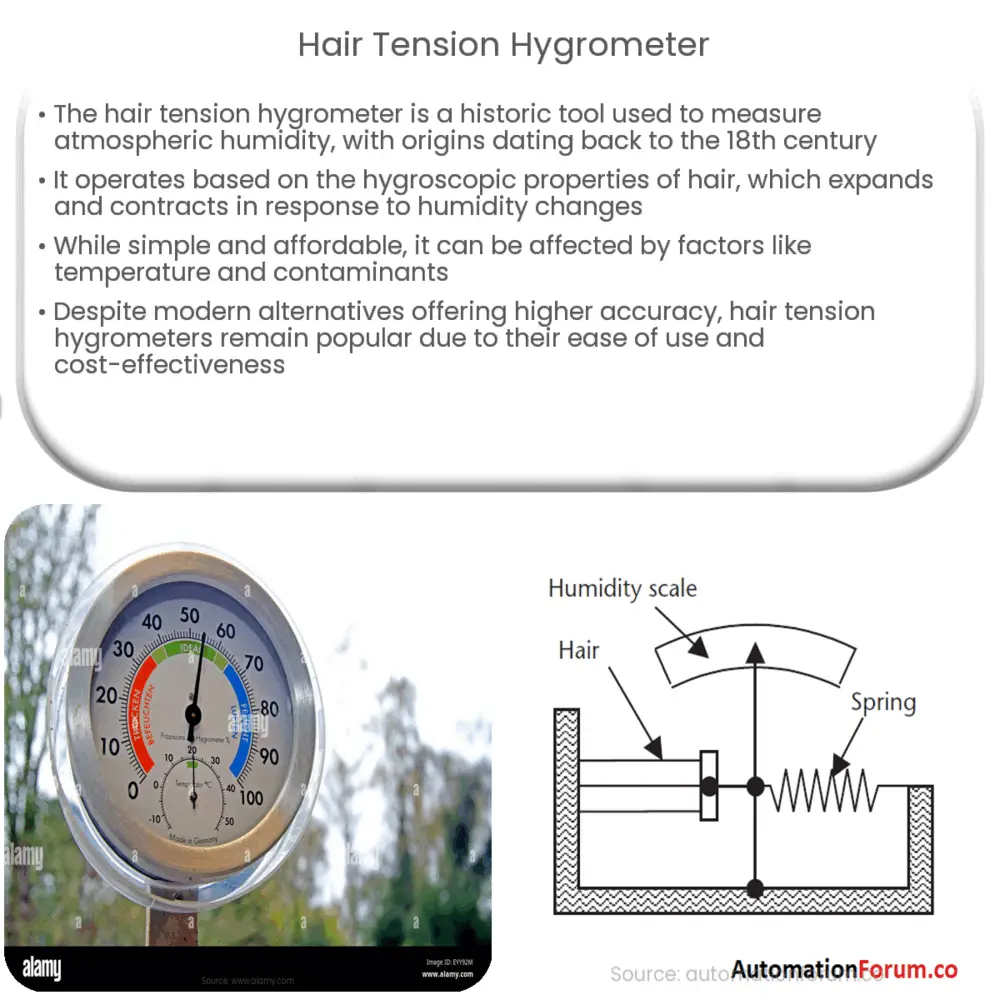Discover the hair tension hygrometer, a simple, cost-effective instrument for measuring humidity, with a rich history and various applications.

Hair Tension Hygrometer: A Time-Tested Tool for Measuring Humidity
In the realm of meteorology, measuring atmospheric humidity is essential for understanding and predicting weather patterns, as well as for various industrial and scientific applications. One of the simplest and most time-tested tools for this purpose is the hair tension hygrometer. This article delves into the history, principles, and applications of this fascinating instrument.
Origins of the Hair Tension Hygrometer
The concept of using hair as a means of measuring humidity dates back to the early 18th century. Swiss polymath Horace Bénédict de Saussure is credited with the invention of the first hair hygrometer in 1783. Saussure’s device, known as the “hygroscope,” used human hair to detect changes in humidity. The device was later refined and evolved into the hair tension hygrometer, which is still in use today.
How It Works: The Science Behind Hair Tension Hygrometers
The hair tension hygrometer functions based on the hygroscopic properties of hair. In essence, hair has the ability to absorb and release water vapor from the surrounding air, causing it to expand and contract as humidity levels fluctuate. As the hair expands, its length increases, and when it contracts, its length decreases. This change in length is directly proportional to the change in humidity.
Typically, a hair tension hygrometer comprises a bundle of untreated human or animal hair, a scale or dial to display humidity levels, and a mechanical linkage system to translate the hair’s movement into a readable output. The hair bundle is secured at one end and attached to the mechanical linkage system at the other end. As the hair absorbs or releases moisture, its change in length causes the linkage system to move, adjusting the position of the indicator on the scale or dial.
While the basic principle remains the same, modern hair tension hygrometers have evolved to incorporate electronic components and sensors for more accurate and reliable readings. These advancements have improved the overall performance of the instrument, making it suitable for a wide range of applications.
Advantages and Limitations of Hair Tension Hygrometers
One of the key advantages of hair tension hygrometers is their simplicity and affordability. With minimal moving parts and no requirement for electricity or batteries, these devices are easy to maintain and operate. Additionally, they provide a reasonable degree of accuracy, making them suitable for general-purpose applications where high precision is not essential.
However, hair tension hygrometers also have some limitations. The response time of the hair to changes in humidity can be relatively slow, leading to a lag in the readings. Additionally, the accuracy of the device can be affected by factors such as temperature, dust, and contaminants present in the hair. Despite these drawbacks, hair tension hygrometers continue to find use in various fields due to their simplicity and cost-effectiveness.
Applications of Hair Tension Hygrometers
Hair tension hygrometers have found their way into various applications across different industries. Some common use cases include:
- Meteorology and Weather Forecasting: Hair tension hygrometers are employed in weather stations to monitor humidity levels, which are crucial for predicting weather patterns and understanding climate change.
- Agriculture: Farmers use these devices to monitor humidity in greenhouses, crop storage facilities, and outdoor fields, ensuring optimal growing conditions and preventing mold and mildew development on crops.
- Indoor Air Quality and Comfort: In residential and commercial buildings, hair tension hygrometers help maintain comfortable humidity levels, reducing the risk of health issues and damage to furniture and electronics caused by excessive humidity or dryness.
- Museums and Art Galleries: Maintaining stable humidity levels is crucial for preserving delicate artifacts and artwork. Hair tension hygrometers are utilized to monitor and maintain appropriate environmental conditions in display and storage areas.
Maintenance and Calibration of Hair Tension Hygrometers
Regular maintenance and calibration are necessary to ensure the ongoing accuracy and reliability of hair tension hygrometers. Maintenance typically involves cleaning the hair bundle to remove dust and contaminants, as well as inspecting the mechanical linkage system for signs of wear or damage.
Calibration is the process of adjusting the hygrometer’s readings to match those of a known reference standard. This can be done using saturated salt solutions, which create a stable and predictable humidity environment. By comparing the hygrometer’s readings with the known humidity levels produced by the salt solutions, any necessary adjustments can be made to the device’s scale or dial.
Alternatives to Hair Tension Hygrometers
While hair tension hygrometers have stood the test of time, there are alternative devices available that offer higher accuracy and faster response times. Some popular alternatives include:
- Capacitive Hygrometers: These devices measure humidity by detecting changes in capacitance between two metal plates as a result of moisture absorption in a hygroscopic dielectric material.
- Resistive Hygrometers: These hygrometers determine humidity levels by measuring the change in resistance of a hygroscopic material, such as a polymer film or ceramic substance, as it absorbs or releases water vapor.
- Chilled Mirror Dew Point Hygrometers: These high-precision instruments measure humidity by cooling a reflective surface until dew or frost forms, then measuring the temperature at which this occurs (the dew point), which is directly related to humidity levels.
Despite the availability of these more advanced alternatives, hair tension hygrometers remain relevant due to their simplicity, affordability, and suitability for general-purpose applications.
Conclusion
As a time-tested instrument, the hair tension hygrometer has played a significant role in the measurement of humidity for centuries. While modern alternatives offer advantages in terms of accuracy and response time, the hair tension hygrometer continues to be a valuable tool for many applications, thanks to its simplicity, cost-effectiveness, and ease of use.

